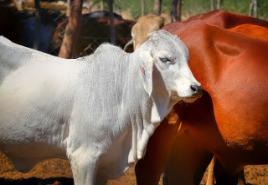Improving surveillance and control of livestock diseases in Tanzania with community, government and industry partners
Published: 6 December 2023
SBOHVM researchers have made significant strides in improving disease surveillance and control of livestock diseases in Tanzania.
Improving surveillance and control of livestock diseases in Tanzania with community, government and industry partners
 SBOHVM researchers have made significant strides in improving disease surveillance and control of livestock diseases in Tanzania. Collaborating with community, government, and industry partners, their efforts have led to policy changes and targeted strategies to combat foot-and-mouth disease (FMD) and anthrax, two prevalent livestock diseases in the country.
SBOHVM researchers have made significant strides in improving disease surveillance and control of livestock diseases in Tanzania. Collaborating with community, government, and industry partners, their efforts have led to policy changes and targeted strategies to combat foot-and-mouth disease (FMD) and anthrax, two prevalent livestock diseases in the country.
Tanzania, home to approximately 30 million cattle, heavily relies on livestock for economic development and social welfare. However, diseases like FMD and anthrax have hindered progress, especially in livestock-dependent communities with limited access to policymakers.
Our research team focused on quantifying the burden of FMD and anthrax in Tanzania, shedding light on the extent of the problem. Their findings revealed that FMD caused a significant decrease in milk yields (67%), livestock sales income (27%), and increased healthcare and education costs for households. Surprisingly, only 5% of households reported vaccinating their livestock against FMD.
Community-based Anthrax Surveillance
Anthrax, a potentially fatal disease for both livestock and humans, was also a major concern. The researchers developed a community-based surveillance approach using domestic dogs as indicators for anthrax. This method helped detect cases in remote areas and facilitated communication among health workers, veterinary and medical officers, and researchers. It was discovered that most sudden livestock deaths were due to anthrax, resulting in significant economic losses and human health complications.
The team also conducted epidemiological studies on FMD, identifying four dominant virus types in Tanzania. Their surveillance efforts resulted in the creation of a biobank containing over 100 virus samples, which can inform vaccine development and vaccination strategies. Contrary to previous beliefs, their work demonstrated that FMD transmission in cattle was primarily driven by livestock-related factors, rather than wildlife-related factors.
Government Policy
The impact of our research extends beyond local communities. Their findings influenced the Tanzanian Government's anthrax and FMD management policies and contributed to the Tanzanian Livestock Modernization Initiative. Tanzania also joined the United Nations Food and Agriculture Organisation's global initiative for FMD control, thanks to the research providing crucial data. Additionally, an anthrax control strategy was developed for the Ngorongoro District, benefiting the local population.
At the community level, our team trained community-based health workers in anthrax surveillance and case management, empowering them to monitor and respond to diseases effectively. They also established communication networks, including a WhatsApp group, to facilitate information sharing and reporting of suspected cases.
The impact of the research was recognized at the national level, leading to policy changes and official recognition of anthrax as a priority zoonotic disease. Tanzania developed a national strategy for anthrax prevention and control, incorporating insights from the project. The Ngorongoro District allocated funds for anthrax vaccination campaigns based on the research team's recommendations.
Future Plans
Moving forward, our researchers aim to develop a vaccination strategy for FMD by collaborating with industry partners. Their efforts have garnered support from MSD Animal Health, which recognizes the value of their research in strengthening FMD surveillance and prevention.
First published: 6 December 2023

